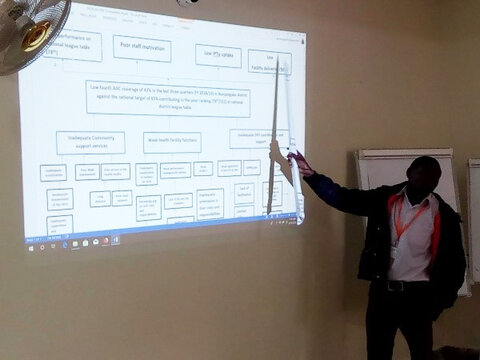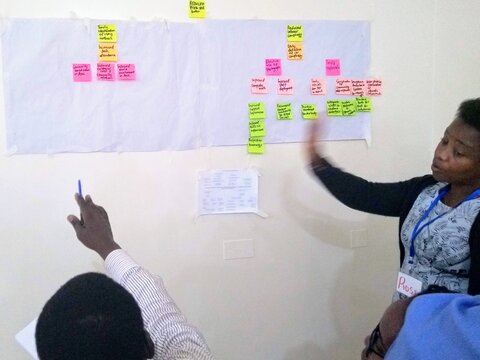Collective reflection on DHMTs’ problems for realistic management strengthening

Paul Mubiri, Research Officer at Makerere University School of Public Health, considers how DHMTs in Uganda used existing data to refine their problems and identify solutions
In June, District Group 2 (Ntoroko, Kabarole and Bunyangabu districts) took part in their second PERFORM2Scale management strengthening intervention (MSI) workshop in Kabarole.
During the workshop the participating districts presented the problem trees they had developed, highlighting the broad problems they had identified, their root causes and the interventions selected to improve their performance.
Interestingly, the teams had shifted from the management and leadership-related problems presented in the first workshop in May (tweets from that workshop here), to those that directly affected measurable performance indicators. For example, the problem identified by one of the districts during workshop one was: “No District Health Management Team meeting in the year 2018”, but for the second workshop they had transitioned to “Fresh still birth rate in Kabarole district was high for the last three qtrs. (FY 2018/2019) averaging at 17.7 per 1,000 births compared to the WHO standard of 5 stillbirths per 1,000 births”. The question was how have they changed their focus?
Interrogating the data

To answer this question, one has to use data. When the district teams returned to their respective districts following workshop one, they considered the reasons for their poor performances in reference to the national league table benchmarks and reflected on the possible explanations. Through a critical review and in-depth analysis of the data, the district health team members were able to identify and articulate the root causes of their selected problems, and were able to further stratify them into community, health facility and district/DHMT level issues. In the example of the high rate of fresh still births, the district team used the data to identify human resource performance issues associated with the stillbirth rate – such as ineffective use of the partograph - and so changed their focus.
This holistic understanding and analysis of the problem is a critical step in the implementation of strategies to address the problem identified by each DHMT in the MSI cycle. During the presentations at workshop 2, the different teams presented their refined problem trees and were given constructive feedback by their peers, and this enabled an easy transition from a ‘problem tree’ to an ‘objective tree’ (see the image below).
The power of teamwork

We noted that team work was essential to the transition from problem trees to strategies and activity workplans for the MSI cycle, and all the DHMTs showed great commitment and energy. This collective effort when analyzing data and reflecting on what had been learnt improved the teams’ focus and increased the sense of ownership within their decision space. This process also demonstrates that the use of existing data is a critical step in the management strengthening intervention, improving health service delivery using the limited available resources.